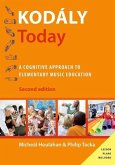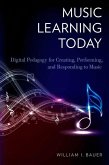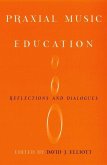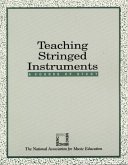Schade – dieser Artikel ist leider ausverkauft. Sobald wir wissen, ob und wann der Artikel wieder verfügbar ist, informieren wir Sie an dieser Stelle.
- Broschiertes Buch
- Merkliste
- Auf die Merkliste
- Bewerten Bewerten
- Teilen
- Produkt teilen
- Produkterinnerung
- Produkterinnerung
Written for music educators from K - 5 onwards, First Instruments is a practical guide to teaching musical ideas through the first instruments we develop in early childhood, laying the foundation for how the collective creativity the book presents can sustain a lifelong commitment to music-making: voice and hand gestures.
Andere Kunden interessierten sich auch für
![Building Better Dictation Skills Building Better Dictation Skills]() Nathan O BuonviriBuilding Better Dictation Skills94,99 €
Nathan O BuonviriBuilding Better Dictation Skills94,99 €![Kodaly Today, 2nd edition Kodaly Today, 2nd edition]() Micheal HoulahanKodaly Today, 2nd edition70,99 €
Micheal HoulahanKodaly Today, 2nd edition70,99 €![Music Learning Today Music Learning Today]() William I BauerMusic Learning Today40,99 €
William I BauerMusic Learning Today40,99 €![Kodaly in the Kindergarten Classroom Kodaly in the Kindergarten Classroom]() Micheal HoulahanKodaly in the Kindergarten Classroom74,99 €
Micheal HoulahanKodaly in the Kindergarten Classroom74,99 €![Urban Music Education Urban Music Education]() Kate Fitzpatrick-HarnishUrban Music Education26,99 €
Kate Fitzpatrick-HarnishUrban Music Education26,99 €![Praxial Music Education Praxial Music Education]() Praxial Music Education53,99 €
Praxial Music Education53,99 €![Teaching Stringed Instruments Teaching Stringed Instruments]() The National Association for Music Education MencTeaching Stringed Instruments51,99 €
The National Association for Music Education MencTeaching Stringed Instruments51,99 €-
-
-
Written for music educators from K - 5 onwards, First Instruments is a practical guide to teaching musical ideas through the first instruments we develop in early childhood, laying the foundation for how the collective creativity the book presents can sustain a lifelong commitment to music-making: voice and hand gestures.
Produktdetails
- Produktdetails
- Verlag: Oxford University Press, USA
- Seitenzahl: 240
- Erscheinungstermin: 1. November 2019
- Englisch
- Abmessung: 251mm x 175mm x 15mm
- Gewicht: 431g
- ISBN-13: 9780190932053
- ISBN-10: 0190932058
- Artikelnr.: 56756053
- Verlag: Oxford University Press, USA
- Seitenzahl: 240
- Erscheinungstermin: 1. November 2019
- Englisch
- Abmessung: 251mm x 175mm x 15mm
- Gewicht: 431g
- ISBN-13: 9780190932053
- ISBN-10: 0190932058
- Artikelnr.: 56756053
Nicholas Bannan is Associate Professor of Music and the University of Western Australia Conservatorium of Music. His earliest musical experience was as a chorister at Canterbury Cathedral, after which he went on to the King's School, where he played violin and viola and composed. Study at Cambridge University, where he was a Choral Exhibitioner at Clare College under John Rutter, led to a career that combined performing, composing and teaching in schools and universities, and as a community musician. Prof. Bannan has developed a reputation for collaborative projects, both within and outside the education sector, including the creative partnership Compose Yourself! He has made a leading contribution to the establishment internationally of the significant new sub-discipline of Evolutionary Musicology, and has taught and published in the field of Teaching and Learning in Music arising from projects both in pedagogy and in reflective practice methodology. His performance experience includes professional choral and orchestral conducting, with special interests in early music, the 20th century, and new music. Formally conductor of The Esterhazy Singers in London, he now directs The Winthrop Singers of UWA and is on the music staff of St Mary's Cathedral, Perth. Prof. Bannan has taught at Eton College; Desborough School, Maidenhead; The Yehudi Menuhin School; the London College of Music; and Oxford Brookes and Reading Universities in the UK.
List of Illustrations
Acknowledgements
About the Companion Website
Introduction
Part 1: Why Singing?
Chapter 1 Musical foundations
Chapter 2 The anatomy of human music-making
Chapter 3 The instinctive and the learned
Chapter 4 Music as 'the missing link': a distinct form of thinking and feeling
Chapter 5 The aural feedback loop and inner hearing
Chapter 6 The four elements of vocal learning
Chapter 7 Lifelong participation and transmission
Part 2: Why Signing?
Chapter 8 Representation and Communication
Chapter 9 The two hemispheres of the brain
Part 3: Patterns of Leadership and Interaction
Chapter 11 Collective Creativity
Chapter 12 Signs about signs: the notation of Harmony Signing
Chapter 13 Working on Your Own
Chapter 14 Working in Pairs
Chapter 15 Working in Groups
Chapter 16 Working with instrumental classes and bands
Chapter 17 Working with vocal classes and choirs
Part 4: Building creatively on Harmony Signing
Chapter 18 What Are Students Expressing Musically?
Appendices
Bibliography
Index
Acknowledgements
About the Companion Website
Introduction
Part 1: Why Singing?
Chapter 1 Musical foundations
Chapter 2 The anatomy of human music-making
Chapter 3 The instinctive and the learned
Chapter 4 Music as 'the missing link': a distinct form of thinking and feeling
Chapter 5 The aural feedback loop and inner hearing
Chapter 6 The four elements of vocal learning
Chapter 7 Lifelong participation and transmission
Part 2: Why Signing?
Chapter 8 Representation and Communication
Chapter 9 The two hemispheres of the brain
Part 3: Patterns of Leadership and Interaction
Chapter 11 Collective Creativity
Chapter 12 Signs about signs: the notation of Harmony Signing
Chapter 13 Working on Your Own
Chapter 14 Working in Pairs
Chapter 15 Working in Groups
Chapter 16 Working with instrumental classes and bands
Chapter 17 Working with vocal classes and choirs
Part 4: Building creatively on Harmony Signing
Chapter 18 What Are Students Expressing Musically?
Appendices
Bibliography
Index
List of Illustrations
Acknowledgements
About the Companion Website
Introduction
Part 1: Why Singing?
Chapter 1 Musical foundations
Chapter 2 The anatomy of human music-making
Chapter 3 The instinctive and the learned
Chapter 4 Music as 'the missing link': a distinct form of thinking and feeling
Chapter 5 The aural feedback loop and inner hearing
Chapter 6 The four elements of vocal learning
Chapter 7 Lifelong participation and transmission
Part 2: Why Signing?
Chapter 8 Representation and Communication
Chapter 9 The two hemispheres of the brain
Part 3: Patterns of Leadership and Interaction
Chapter 11 Collective Creativity
Chapter 12 Signs about signs: the notation of Harmony Signing
Chapter 13 Working on Your Own
Chapter 14 Working in Pairs
Chapter 15 Working in Groups
Chapter 16 Working with instrumental classes and bands
Chapter 17 Working with vocal classes and choirs
Part 4: Building creatively on Harmony Signing
Chapter 18 What Are Students Expressing Musically?
Appendices
Bibliography
Index
Acknowledgements
About the Companion Website
Introduction
Part 1: Why Singing?
Chapter 1 Musical foundations
Chapter 2 The anatomy of human music-making
Chapter 3 The instinctive and the learned
Chapter 4 Music as 'the missing link': a distinct form of thinking and feeling
Chapter 5 The aural feedback loop and inner hearing
Chapter 6 The four elements of vocal learning
Chapter 7 Lifelong participation and transmission
Part 2: Why Signing?
Chapter 8 Representation and Communication
Chapter 9 The two hemispheres of the brain
Part 3: Patterns of Leadership and Interaction
Chapter 11 Collective Creativity
Chapter 12 Signs about signs: the notation of Harmony Signing
Chapter 13 Working on Your Own
Chapter 14 Working in Pairs
Chapter 15 Working in Groups
Chapter 16 Working with instrumental classes and bands
Chapter 17 Working with vocal classes and choirs
Part 4: Building creatively on Harmony Signing
Chapter 18 What Are Students Expressing Musically?
Appendices
Bibliography
Index







